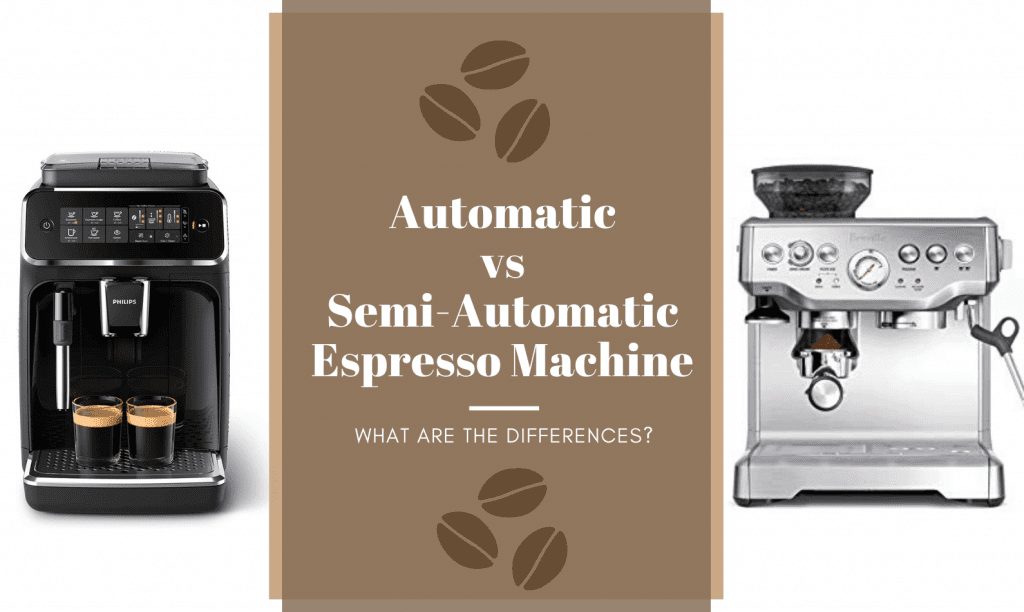Automatic vs Semi-Automatic Espresso Machine: What are the Differences? Espresso machines have a pretty interesting history, going through several innovations before arriving at the modern beauties we see today. They came to supply a way of management and convenience that isn’t potential with recent manual production strategies. Exploring the choices for a home coffee machine will be a touch intimidating. One of the most confusing things you must decide is what type of espresso machine you’d like regarding how hands-on you want to be.
The 3 main varieties – Semi-Automatic, Automatic, and Super-automatic. They all offer a different set of benefits, but they can be hard to differentiate when you’re new to the espresso space. I don’t know who named these machine types, but they didn’t do you any favors – they just made it more confusing by using “automatic” in every name. I’m going to break down the differences between automatic and semi-automatic espresso machines so you can easily decide which one is right for your lifestyle and preferences. Of course, with these innovations came disputes over what’s the simplest thanks to brewing your coffee. The main partition emerges around semi-automatic vs automatic machines.
Espresso In the Beginning:
Espresso machine history begins in the age of steam with a man named Angelo Moriondo. He is attributable for making the primary iteration of the trendy coffee machine, which used steam, higher pressure, and tightly packed grounds. Luigi Bezerra and Desiderio Pavoni each improved upon Moriondo’s design. They formed several of today’s coffee machines’ key components, including the portafilter, pressure release valve, and steam wand. Achille Gaggia (a brand name that still exists today) finally introduced the barista-operated spring-piston lever, which improved pressure control. This is wherever “pulling a shot,” and therefore, the crema packaging came to life.
The Standards:
Regardless of what machine pulls your shot, a decent machine can use an analogous method and production parameters to realize the simplest coffee. To pull a shot, 190°-200° F water is pumped through a “puck” (tightly packed disk) of very finely ground coffee beans. This is done with at least 9 atmospheres of pressure and produces about one ounce of espresso.
Semi-Automatic Espresso Machines
Semi-automatic machines were developed as an associate improvement to Gaggia’s style. In 1961, Ernesto Valente developed a style that used a motorized pump mechanism that eliminated the necessity for a barista to manually pump the piston to realize the pressure needed for a shot. This is the planning off of that semi-automatic machines are still primarily based.
A barista merely uses a button or lever to begin the shot propulsion and decides once to prevent it. The second part of that’s extremely what separates semi-automatics from totally and super-automatics. The barista, rather than the machine, decide exactly when the shot is done. These machines also typically require you to grind and tamp (press the grounds to create your beans’ puck we mentioned earlier). Now, semi-automatics are more commonly used in commercial settings and tend to have more group heads to pull several shots at once or in close succession.
These machines have an electrical pump that generates bonded 8-9 bars of pressure – the optimum vary for production coffee. As its name suggests, you’ll still have to do a little bit of work before you can start brewing. You’ll still get to grind and tamp the coffee so it fits properly into the portafilter. But once you attach the portafilter, the machine can take over and continue the production method. Semi-automatic machines are what I, in person, have the foremost experts with. They’re the foremost in the style of home production machines and tend to be the foremost cheap choice. Plus, they also give you the option of brewing tea or cafe Americanos.
Automatic Espresso Machines
Fully-automatic machines are very similar to semi-automatic machines. The only real distinction between the 2 is that fully-automatic machines are a one-touch production system. Flip it on, and therefore the machine can management the quantity of water pushed through the grounds. Once the pre-determined quantity of coffee is brewed, the machine will stop automatically. A fully-automatic machine may be a nice choice for multitaskers.
If you intend to do alternative things while you’re producing your coffee, this might be the right option for you. Fully-automatic machines are employed in industrial coffee retailers; thus, they unlock the barista’s hands, allowing them to prepare multiple drinks at once. As a way as quality thinks about, fully- and semi-automatic machines are right on par. The one advantage semi-automatic machines have is that they’re cheaper. The selection of fully-automatic machines for home brewing is also limited. Aside from semi- and fully-automatic coffee machines, you’ll also find super-automatic.
Automatic Espresso Machines Features:
These brewers take it one step further by adding in a burr grinder. With only 1 bit of a button, the machine will grind the beans and brew up a fresh cup of fresh, delicious espresso. Of course, you also have the option of choosing between other drinks (sometimes dozens), such as cappuccino, latte, and macchiato. In short, semi-automatic machines take plenty of the dead reckoning out of production coffee. Grind the beans, tamp and attach the portafilter.
The machine takes care of the rest. Fully-automatic machines take it one step more by mechanically dominant the quantity of water pushed through the grounds. While fully- and super-automatic machines are extremely convenient, they come at much higher prices than semi-automatic machines. If you have got the budget, the added convenience may be worth the extra price. But for the common espresso-lover, a semi-automatic machine may be a sensible choice.
These machines feature what is often referred to as a “flowmeter.” The flowmeter monitors and controls exactly how much water passes through the puck and stops the flow when the appropriate amount has filtered through. While these machines DO automatize the production method, they do NOT do all of the work for you. You are still going to have to grind and tamp your beans, like with a semi-automatic. Additionally, several of those machines embody semi-automatic redundancy options (the opposite is additionally true). So the 2 are usually listed within the other’s section on shopping for sites, and few machines are merely marketed as “fully automatic.”
Automatic Vs Semi-Automatic Espresso Machine: How to Choose?
-
Lifestyle
If you have a super busy lifestyle, tamping and grinding your beans probably isn’t work for you. In that case, a super-automatic machine may be the thanks to going. Conversely, if you prefer to own your coffee production as a “moment” in your day, try a semi-automatic. These machines can provide you with an additional intimate association with your production expertise since you’re way more concerned.
-
Cost
As a baseline, a super-automatic machine goes to be costlier than a semi-automatic machine. Machines with additional fully-automatic capabilities typically fall somewhere within the middle. However, you may have to purchase certain accessories, such as a grinder to go with your machine, especially semi-automatics. So, keep that in mind before you buy it. Regardless of that machine, you decide on; chances are it’ll pay for itself within a year if you’re a coffee shop regular. It’s worth saving up for, in our opinion.
Automatic Vs Semi-Automatic Espresso Machine: Which is Better?
When it comes down to purchasing a machine, some people use how much maintenance is required to decide what machine to get. While this is often not a foul issue to stay in mind, you should be prepared to do regular maintenance on either a semi-automatic or superautomatic machine. Semi-automatic machines do indeed require a little more maintenance since you will have to clean the portafilters, baskets, and shower screen.
Automatic Vs Semi-Automatic Espresso Machine: The Final Verdict
However, super autos need TLC too, and there are some steps like cleaning the brew group, steam valve, and steam wand that are important to perform no matter what type of machine you have. Ultimately, what is most important when picking out a machine is determining what you want to get out of your machine and what features are most important. Now that you know a little more about each type, hopefully, you can figure out which will work best for you.
Read more about Best Espresso Machine Under $200: Best Choices 2022
We recommend getting a semi-automatic machine if you have a taste for the nuances in your espresso. They give you the greatest amount of control over your brew. Plus, if you’re willing to splurge on a high-end semi-automatic machine, you may most likely even have absolutely automatic options to utilize once you are busier.





